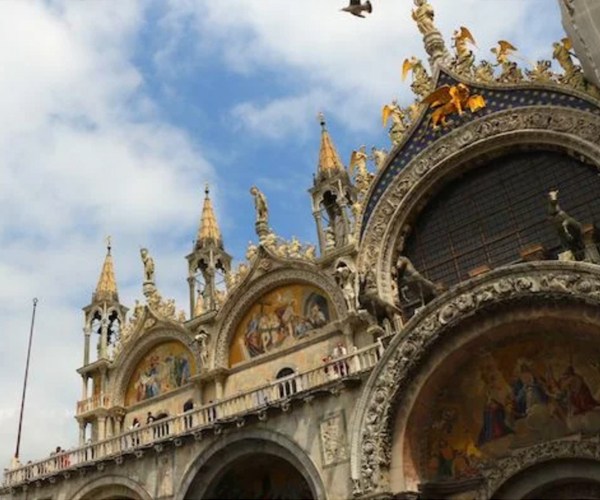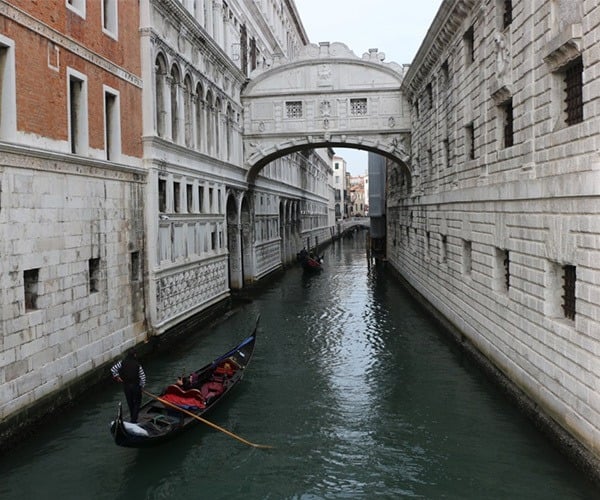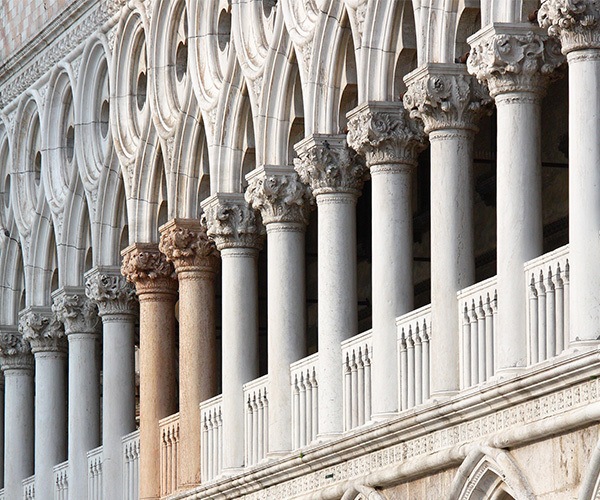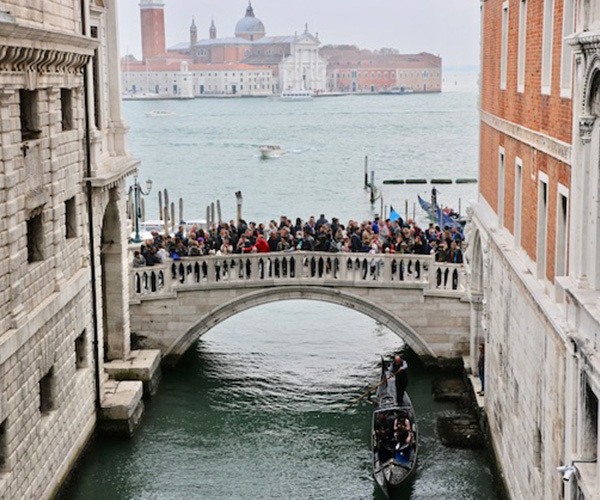Europe · Italy · Regions · Western Europe
Fun facts to know about Venice
Like most cities in Italy, the birth of Venice has a history of myths and tales. The inhabitants of Aquileia laid the foundations for this unique city in the 5th century A.D.. Its storied origins and unique location makes Venice an intriguing city to visit. Here are 7 interesting facts you need to know before you visit Venice.
 1. Venice is the shape of a fish
Many travelers visiting Venice for the first time wonder how momentous structures like the Campanile di San Marco or the Basilica di San Marco have withstood the test of time. Construction in Venice must endure water, salty air, mud and sand. Through a system of building stilts and preventing leaks with mud, bricks and waste material, Venetians engineered a cemented foundation that’s held for centuries. Who would have guessed that from the air, Venice takes the shape of a fish?! Oh, the irony!
2. Sirens in Venice alert people of “Acqua Alta”
The sirens once signal air strikes during WWII are still fixed atop the bell towers in Venice. Today, those same sirens alert people Acqua Alta is about to hit. Acqua Alta in english means “high water” and occurs when the canals’ water level suddenly rises above the pavement and floods into the streets. This phenomenon is relatively recent in Venice’s history. When the sirens sound, you’ll notice Venetians quickly securing iron plates in doorways to prevent the high waters from entering their homes.
3. Venice is home to one of the narrowest streets in the world
Calletta (as in “small street”) Varisco is located near Campo San Canciano in Venice and happens to be one of the narrowest streets in the world measuring 53 cm in width. Venitian streets are characteristically narrow, given the main form of transportation takes place in canals. Naturally, streets were built to move between houses, but were not originally conceived for heavy traffic hence why the main gates of most old buildings in Venice are still facing the canals.
4. Becoming a gondolier is not easy
The Gondola is one of the most recognizable symbols of Venice and a very popular tourist attraction. Not many people know that becoming a licensed gondola rider, or “gondolièr” is not an easy feet. These centuries old narrow boats easily navigate across the canals because of their elongated shape. It’s because of this shape that they must be helmed by skilled oarsmen. Hundreds of eager men apply each year while only 3 to 4 manage to get the license.
1. Venice is the shape of a fish
Many travelers visiting Venice for the first time wonder how momentous structures like the Campanile di San Marco or the Basilica di San Marco have withstood the test of time. Construction in Venice must endure water, salty air, mud and sand. Through a system of building stilts and preventing leaks with mud, bricks and waste material, Venetians engineered a cemented foundation that’s held for centuries. Who would have guessed that from the air, Venice takes the shape of a fish?! Oh, the irony!
2. Sirens in Venice alert people of “Acqua Alta”
The sirens once signal air strikes during WWII are still fixed atop the bell towers in Venice. Today, those same sirens alert people Acqua Alta is about to hit. Acqua Alta in english means “high water” and occurs when the canals’ water level suddenly rises above the pavement and floods into the streets. This phenomenon is relatively recent in Venice’s history. When the sirens sound, you’ll notice Venetians quickly securing iron plates in doorways to prevent the high waters from entering their homes.
3. Venice is home to one of the narrowest streets in the world
Calletta (as in “small street”) Varisco is located near Campo San Canciano in Venice and happens to be one of the narrowest streets in the world measuring 53 cm in width. Venitian streets are characteristically narrow, given the main form of transportation takes place in canals. Naturally, streets were built to move between houses, but were not originally conceived for heavy traffic hence why the main gates of most old buildings in Venice are still facing the canals.
4. Becoming a gondolier is not easy
The Gondola is one of the most recognizable symbols of Venice and a very popular tourist attraction. Not many people know that becoming a licensed gondola rider, or “gondolièr” is not an easy feet. These centuries old narrow boats easily navigate across the canals because of their elongated shape. It’s because of this shape that they must be helmed by skilled oarsmen. Hundreds of eager men apply each year while only 3 to 4 manage to get the license.
 5. The pink columns of Palazzo Ducale revealed
While admiring the columns in Palazzo Ducale you can easily spot two that differ from the rest. What’s the reason behind their pink hue? These columns mark where criminal sentences were traditionally read and their fateful executions took place. Scaffolding was placed directly at the height of the columns facing the clock tower so the condemned would see their time of death. The pink color symbolizes the blood of the convicted.
5. The pink columns of Palazzo Ducale revealed
While admiring the columns in Palazzo Ducale you can easily spot two that differ from the rest. What’s the reason behind their pink hue? These columns mark where criminal sentences were traditionally read and their fateful executions took place. Scaffolding was placed directly at the height of the columns facing the clock tower so the condemned would see their time of death. The pink color symbolizes the blood of the convicted.
 6. The Wars of the Punches
In ancient times, Venice was split into two factions including the Castellani, from the east side of the city, and the Nicolotti, from the west. The relentless feud began in 1300, and was dubbed “Guerre dei Pugni”, or “Wars of the Punches”. The fights were particularly bloody taking place on several famous bridges in Venice; the most famous being Ponte dei Carmini, Ponte di Santa Fosca, Ponte della Guerra, and Ponte dei Pugni. The wars’ endgame was to conquer the bridge and make it private resulting in many injuries and deaths given most participants fell off the bridge. The fighting became so intense that the Doge banned these scuffles for good in 1705.
6. The Wars of the Punches
In ancient times, Venice was split into two factions including the Castellani, from the east side of the city, and the Nicolotti, from the west. The relentless feud began in 1300, and was dubbed “Guerre dei Pugni”, or “Wars of the Punches”. The fights were particularly bloody taking place on several famous bridges in Venice; the most famous being Ponte dei Carmini, Ponte di Santa Fosca, Ponte della Guerra, and Ponte dei Pugni. The wars’ endgame was to conquer the bridge and make it private resulting in many injuries and deaths given most participants fell off the bridge. The fighting became so intense that the Doge banned these scuffles for good in 1705.
 7. Venitian cats, not the musical
Cats first arrived in Venice from the Middle East and instantly became beloved pets to Venetian people. They served to combat a pressing issue at the time: an overpopulation of mice. In Venice, not many cats are stray. Most reside in designated “cat sanctuaries”, with Venetian families, or the traditional “gattare“ or cat ladies. Rumor has it that Francesco Morosini,a popular Doge of Venice, was so fond of his cat that he brought her with him to war.
Sean Finelli is CEO at The Tour Guy. The Tour Guy and its suite of brands, The Roman Guy and Finelli & Shaw, offer globetrotters uniquely curated experiences across Europe.
If you would like to be a guest blogger on A Luxury Travel Blog in order to raise your profile, please contact us.
7. Venitian cats, not the musical
Cats first arrived in Venice from the Middle East and instantly became beloved pets to Venetian people. They served to combat a pressing issue at the time: an overpopulation of mice. In Venice, not many cats are stray. Most reside in designated “cat sanctuaries”, with Venetian families, or the traditional “gattare“ or cat ladies. Rumor has it that Francesco Morosini,a popular Doge of Venice, was so fond of his cat that he brought her with him to war.
Sean Finelli is CEO at The Tour Guy. The Tour Guy and its suite of brands, The Roman Guy and Finelli & Shaw, offer globetrotters uniquely curated experiences across Europe.
If you would like to be a guest blogger on A Luxury Travel Blog in order to raise your profile, please contact us.
 1. Venice is the shape of a fish
Many travelers visiting Venice for the first time wonder how momentous structures like the Campanile di San Marco or the Basilica di San Marco have withstood the test of time. Construction in Venice must endure water, salty air, mud and sand. Through a system of building stilts and preventing leaks with mud, bricks and waste material, Venetians engineered a cemented foundation that’s held for centuries. Who would have guessed that from the air, Venice takes the shape of a fish?! Oh, the irony!
2. Sirens in Venice alert people of “Acqua Alta”
The sirens once signal air strikes during WWII are still fixed atop the bell towers in Venice. Today, those same sirens alert people Acqua Alta is about to hit. Acqua Alta in english means “high water” and occurs when the canals’ water level suddenly rises above the pavement and floods into the streets. This phenomenon is relatively recent in Venice’s history. When the sirens sound, you’ll notice Venetians quickly securing iron plates in doorways to prevent the high waters from entering their homes.
3. Venice is home to one of the narrowest streets in the world
Calletta (as in “small street”) Varisco is located near Campo San Canciano in Venice and happens to be one of the narrowest streets in the world measuring 53 cm in width. Venitian streets are characteristically narrow, given the main form of transportation takes place in canals. Naturally, streets were built to move between houses, but were not originally conceived for heavy traffic hence why the main gates of most old buildings in Venice are still facing the canals.
4. Becoming a gondolier is not easy
The Gondola is one of the most recognizable symbols of Venice and a very popular tourist attraction. Not many people know that becoming a licensed gondola rider, or “gondolièr” is not an easy feet. These centuries old narrow boats easily navigate across the canals because of their elongated shape. It’s because of this shape that they must be helmed by skilled oarsmen. Hundreds of eager men apply each year while only 3 to 4 manage to get the license.
1. Venice is the shape of a fish
Many travelers visiting Venice for the first time wonder how momentous structures like the Campanile di San Marco or the Basilica di San Marco have withstood the test of time. Construction in Venice must endure water, salty air, mud and sand. Through a system of building stilts and preventing leaks with mud, bricks and waste material, Venetians engineered a cemented foundation that’s held for centuries. Who would have guessed that from the air, Venice takes the shape of a fish?! Oh, the irony!
2. Sirens in Venice alert people of “Acqua Alta”
The sirens once signal air strikes during WWII are still fixed atop the bell towers in Venice. Today, those same sirens alert people Acqua Alta is about to hit. Acqua Alta in english means “high water” and occurs when the canals’ water level suddenly rises above the pavement and floods into the streets. This phenomenon is relatively recent in Venice’s history. When the sirens sound, you’ll notice Venetians quickly securing iron plates in doorways to prevent the high waters from entering their homes.
3. Venice is home to one of the narrowest streets in the world
Calletta (as in “small street”) Varisco is located near Campo San Canciano in Venice and happens to be one of the narrowest streets in the world measuring 53 cm in width. Venitian streets are characteristically narrow, given the main form of transportation takes place in canals. Naturally, streets were built to move between houses, but were not originally conceived for heavy traffic hence why the main gates of most old buildings in Venice are still facing the canals.
4. Becoming a gondolier is not easy
The Gondola is one of the most recognizable symbols of Venice and a very popular tourist attraction. Not many people know that becoming a licensed gondola rider, or “gondolièr” is not an easy feet. These centuries old narrow boats easily navigate across the canals because of their elongated shape. It’s because of this shape that they must be helmed by skilled oarsmen. Hundreds of eager men apply each year while only 3 to 4 manage to get the license.
 5. The pink columns of Palazzo Ducale revealed
While admiring the columns in Palazzo Ducale you can easily spot two that differ from the rest. What’s the reason behind their pink hue? These columns mark where criminal sentences were traditionally read and their fateful executions took place. Scaffolding was placed directly at the height of the columns facing the clock tower so the condemned would see their time of death. The pink color symbolizes the blood of the convicted.
5. The pink columns of Palazzo Ducale revealed
While admiring the columns in Palazzo Ducale you can easily spot two that differ from the rest. What’s the reason behind their pink hue? These columns mark where criminal sentences were traditionally read and their fateful executions took place. Scaffolding was placed directly at the height of the columns facing the clock tower so the condemned would see their time of death. The pink color symbolizes the blood of the convicted.
 6. The Wars of the Punches
In ancient times, Venice was split into two factions including the Castellani, from the east side of the city, and the Nicolotti, from the west. The relentless feud began in 1300, and was dubbed “Guerre dei Pugni”, or “Wars of the Punches”. The fights were particularly bloody taking place on several famous bridges in Venice; the most famous being Ponte dei Carmini, Ponte di Santa Fosca, Ponte della Guerra, and Ponte dei Pugni. The wars’ endgame was to conquer the bridge and make it private resulting in many injuries and deaths given most participants fell off the bridge. The fighting became so intense that the Doge banned these scuffles for good in 1705.
6. The Wars of the Punches
In ancient times, Venice was split into two factions including the Castellani, from the east side of the city, and the Nicolotti, from the west. The relentless feud began in 1300, and was dubbed “Guerre dei Pugni”, or “Wars of the Punches”. The fights were particularly bloody taking place on several famous bridges in Venice; the most famous being Ponte dei Carmini, Ponte di Santa Fosca, Ponte della Guerra, and Ponte dei Pugni. The wars’ endgame was to conquer the bridge and make it private resulting in many injuries and deaths given most participants fell off the bridge. The fighting became so intense that the Doge banned these scuffles for good in 1705.
 7. Venitian cats, not the musical
Cats first arrived in Venice from the Middle East and instantly became beloved pets to Venetian people. They served to combat a pressing issue at the time: an overpopulation of mice. In Venice, not many cats are stray. Most reside in designated “cat sanctuaries”, with Venetian families, or the traditional “gattare“ or cat ladies. Rumor has it that Francesco Morosini,a popular Doge of Venice, was so fond of his cat that he brought her with him to war.
Sean Finelli is CEO at The Tour Guy. The Tour Guy and its suite of brands, The Roman Guy and Finelli & Shaw, offer globetrotters uniquely curated experiences across Europe.
If you would like to be a guest blogger on A Luxury Travel Blog in order to raise your profile, please contact us.
7. Venitian cats, not the musical
Cats first arrived in Venice from the Middle East and instantly became beloved pets to Venetian people. They served to combat a pressing issue at the time: an overpopulation of mice. In Venice, not many cats are stray. Most reside in designated “cat sanctuaries”, with Venetian families, or the traditional “gattare“ or cat ladies. Rumor has it that Francesco Morosini,a popular Doge of Venice, was so fond of his cat that he brought her with him to war.
Sean Finelli is CEO at The Tour Guy. The Tour Guy and its suite of brands, The Roman Guy and Finelli & Shaw, offer globetrotters uniquely curated experiences across Europe.
If you would like to be a guest blogger on A Luxury Travel Blog in order to raise your profile, please contact us.Did you enjoy this article?
Receive similar content direct to your inbox.


I’m intrigued by the idea of training to become a gondolièr. I wonder what the test and training involves. Do they have a L plate on their gondola when they are training? Do they need to learn “the knowledge” knowing their way round the city’s canals like London cabbies have to in their home town. Or do they use sat nav to find their way around? Do they have to sing? So often in adverts and films the gondolièrs burst out into song. And why is it that so few of them make it through the training successfully?
Recently I visited Cordoba and it has some narrow streets in its Jewish Quarter and I remember that a website said the narrowest alleyway was just a little wider than a budget airline seat so this street in Venice is pretty narrow. But if you do your research you’ll find an unpronounceable Street in Baden Wurttemburg, Germany that is just over 12 inches wide.
And here I thought flying coach was rough. I can’t imagine traversing foot wide streets!
I’ve visited Venice a few times but I would never have known that it is shaped line s fish. I’m going to have to Google aerial pictures of Venice now to see for myself.
What would we do without Google Earth?! Oddly enough, when you view Venice from the air, a fish appears.
Streets in old traditional Middle Eastern cities are just as narrow as those of Venice. To add to the effect of narrowness houses on first floor fronting such streets project out into the streets on both sides almost touching each other. These projecting parts are covered in wooden blinds for privacy and protection from the sun. The whole intention is to create pedestrian streets that are almost covered over against the hot sun
I’m due to visit Venice in late October when there may be a bit of rain about and I didn’t know a thing about the sirens. I had never heard of Acqua Alta and the warning. Many thanks for some valuable information.
You’re welcome! I’m glad you learned a little something before your trip.
I think to hear the world war air sirens going off would be terrifying! That said, it’s also a really good idea and it’s good that Venice is more prepared for high waters. We could do with being more prepared and able to manage weather related problems and flooding in the UK; we could learn a thing or two from Venice. I must admit I’ve never considered how one would go about becoming a gondolier. Really small point here, but there’s a tiny spelling error in that paragraph for number 4, where it says “easy feet” instead of “easy feat”. It’s sweet that there are cat sanctuaries in Venice, and I’ve learned a new word with gattare. It’s a wonderfully compassionate thing to do.
A surprise siren alert would definitely startle me. I hope by reading you’ll be prepared when you visit! Thank you for pointing our the spelling error.
At least I know now what it means if I’m in Venice and hear the sirens sound. It makes me think about how many other cities throughout the world have their own warning systems that might puzzle tourists.
Really interesting piece. Good to scratch below the surface and get down to some of the tiny details that really reveal Venice’s unique character. Though I can’t ever remember seeing that many cats around, perhaps they are so cosseted that they are not allowed out.
I’m not sure that the condemned criminals seeing the pink columns at the Palazzo Ducale would have called that a fun fact. Maybe there could be another post on Venice: 7 macabre facts.
Running with that idea it would be brilliant if other A Luxury Travel Bloggers could follow suit. Recently there was a fascinating post on left-field activities to do in Moscow. Once you scratch under the surface almost every destination has its wacky side.
I wonder where the gondoliers go to learn their trade. Do they go on the canals with L Plates? I expect that some of them find it very tough physically, after all they are on their feet for several hours every day. How close is it to a driving test, is there a theory exam? I expect the safety requirements are tough as they would be expected to rescue people who have fallen into the canals.